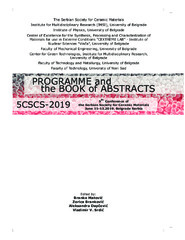Приказ основних података о документу
Spark plasma sintering of conductive Sb-doped BaSnO3
| dc.creator | Vukašinović, Jelena | |
| dc.creator | Počuča-Nešić, Milica | |
| dc.creator | Luković Golić, Danijela | |
| dc.creator | Dapčević, Aleksandra | |
| dc.creator | Kocen, Matej | |
| dc.creator | Bernik, Slavko | |
| dc.creator | Lazović, Vladimir | |
| dc.creator | Branković, Zorica | |
| dc.creator | Branković, Goran | |
| dc.date.accessioned | 2023-08-07T09:33:17Z | |
| dc.date.available | 2023-08-07T09:33:17Z | |
| dc.date.issued | 2019 | |
| dc.identifier.isbn | 978-86-80109-22-0 | |
| dc.identifier.uri | http://rimsi.imsi.bg.ac.rs/handle/123456789/2037 | |
| dc.description.abstract | Barium stannate, BaSnO3, belongs to the group of perovskite-type alkaline earth stannates. It is an electrical insulator, but doping with proper cation can change its’ electrical properties and transform it into an n-type semiconductor. In this work, we present the Sb-doped barium stannate, BaSn1-xSbxO3, x = 0.00, 0.04, 0.06, 0.08 and 0.10 (labelled as BSSOx100), using BaCO3, SnO2 and Sb2O5 as starting materials. Mechanically activated precursors were calcined at 900 °C for 4 h and subsequently sintered by Spark Plasma Sintering (SPS) Technique. For the characterization of obtained ceramic samples various techniques were used: X-ray Diffraction (XRD) analysis, High Resolution Transmission and Field Emission electron microscopy (HRTEM and FESEM) and UV-Vis spectroscopy. Electrical conductivity of BaSn1-xSbxO3 ceramic samples was determined by measuring the current-voltage (I–U) characteristics in different mediums (air, silicon oil) at room temperature and temperatures up to 150 °C. XRD analysis confirmed the formation of the cubic BaSnO3 perovskite phase as a major, and tetragonal Ba2SnO4 as a secondary phase. The content of Ba2SnO4 phase decreased with introducing of Sb into the BaSnO3 lattice. FESEM micrographs of fractured BaSn1-xSbxO3 ceramic samples showed well-densified microstructure and decrease of grain size with the increment of x. HRTEM analyses revealed the existence of low angle grain boundary (LAGB), which provides low energy conduction path of electrons. The results obtained from UV-Vis spectroscopy, indicated the decrease of band gap value of BaSn1-xSbxO3 samples with increasing Sb concentration. Electrical characterization confirmed that Sbdoped BaSnO3 exhibits n-type conductivity. BaSn1-xSbxO3 samples with x = 0.04, 0.06, 0.08 showed linear I–U characteristics at temperatures up to 150 ºC. The highest electrical conductivity was 1.96 S/cm for the BaSn0.92Sb0.08O3. The increase of Sb concentration to x = 0.10 led to the loss of I–U characteristics' linearity. | sr |
| dc.language.iso | en | sr |
| dc.publisher | University of Belgrade, Institute for Multidisciplinary Research | sr |
| dc.relation | Ministry of Education, Science and Technological Development, Republic of Serbia, Grant no. 200053 (University of Belgrade, Institute for Multidisciplinary Research) (RS-200053) | sr |
| dc.rights | openAccess | sr |
| dc.source | 5th Conference of the Serbian Society for Ceramic Materials, 5CSCS-2019, June 11-13, 2019, Belgrade | sr |
| dc.subject | BaSnO3 | sr |
| dc.subject | Sb-doping | sr |
| dc.subject | Spark Plasma Sintering | sr |
| dc.subject | HRTEM analysis | sr |
| dc.subject | Low angle grain boundary | sr |
| dc.subject | I–U characteristic | sr |
| dc.title | Spark plasma sintering of conductive Sb-doped BaSnO3 | sr |
| dc.type | conferenceObject | sr |
| dc.rights.license | ARR | sr |
| dc.citation.spage | 136 | |
| dc.identifier.fulltext | http://rimsi.imsi.bg.ac.rs/bitstream/id/5357/bitstream_5357.pdf | |
| dc.identifier.rcub | https://hdl.handle.net/21.15107/rcub_rimsi_2037 | |
| dc.type.version | publishedVersion | sr |

